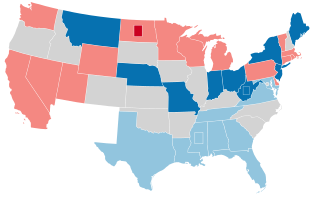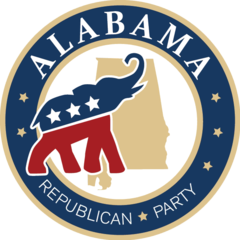
George Corley Wallace Jr. was the 45th governor of Alabama, serving from 1963 to 1967, again from 1971 to 1979, and finally from 1983 to 1987. He is remembered for his staunch segregationist and populist views; however, in the late 1970s, Wallace moderated his views on race, renouncing his support for segregation. During Wallace's tenure as governor of Alabama, he promoted "industrial development, low taxes, and trade schools." Wallace unsuccessfully sought the United States presidency as a Democratic Party candidate three times, and once as an American Independent Party candidate, carrying five states in the 1968 election. Wallace opposed desegregation and supported the policies of "Jim Crow" during the Civil Rights Movement, declaring in his infamous 1963 inaugural address that he stood for "segregation now, segregation tomorrow, segregation forever".

Lurleen Burns Wallace was an American politician who served as the 46th governor of Alabama for 16 months from January 16, 1967, until her death on May 7, 1968. She was the first wife of Alabama governor George Wallace, whom she succeeded as governor because at the time the Alabama constitution forbade consecutive terms.

Emmet O'Neal was an American Democratic politician and lawyer who was the 34th Governor of Alabama from 1911 to 1915. He was a reformer in the progressive mold and is best known for securing the commission form of government for the cities of Alabama.

Braxton Bragg Comer was an American politician who served as the 33rd governor of Alabama from 1907 to 1911, and a United States senator in 1920. As governor, Comer presided over several reforms such as railroad regulation and the lowering of business rates in Alabama to make them more competitive with other states. He also increased funding for the public school system, resulting in more rural schools and high schools in each county for white students and a rise in the state's literacy rate.

Rufus Willis Cobb was an American Democratic politician who was the 25th Governor of Alabama from 1878 to 1882. He is the only person to serve as both Governor of Alabama and Grand Master of the Grand Lodge of Alabama at the same time.

William Wyatt Bibb was a United States Senator from Georgia, the first governor of the Alabama Territory, and the first Governor of the U.S. state of Alabama. Bibb was a member of the Democratic-Republican Party and served as governor of Alabama until his death on July 10, 1820, from a horse riding accident. He is the first of only three people in U.S. history to be elected a U.S. Senator from one state and the governor of another. Bibb County, Alabama, and Bibb County, Georgia, are named for him.

John Hollis Bankhead was an American politician and Confederate Army soldier. A member of the Democratic Party, Bankhead served as U.S. Senator from the state of Alabama from 1907 until his death in 1920. Bankhead had additionally served in the United States House of Representatives, the Alabama Legislature, and as warden of the state penitentiary in Wetumpka.

Events from the year 1833 in the United States.

The Supreme Court of Alabama is the highest court in the state of Alabama. The court consists of a chief justice and eight associate justices. Each justice is elected in partisan elections for staggered six-year terms. The Supreme Court is housed in the Heflin-Torbert Judicial Building in downtown Montgomery, Alabama.

The 1910–11 United States Senate election were held on various dates in various states. As these U.S. Senate elections were prior to the ratification of the Seventeenth Amendment in 1913, senators were primarily chosen by state legislatures. Senators were elected over a wide range of time throughout 1910 and 1911, and a seat may have been filled months late or remained vacant due to legislative deadlock. However, some states had already begun direct elections during this time. Oregon pioneered direct election and experimented with different measures over several years until it succeeded in 1907. Soon after, Nebraska followed suit and laid the foundation for other states to adopt measures reflecting the people's will. By 1912, as many as 29 states elected senators either as nominees of their party's primary or in conjunction with a general election.
The Alabama Public Service Commission, commonly called the PSC, was established by an act of the Alabama Legislature in 1915 to primarily replace the State Railroad Commission. The PSC's responsibility was expanded in 1920 to include regulating and setting rates that utility companies charge their customers for electricity. The legislature expanded the PSC's responsibilities in later years to include those companies that provide gas, water, and communications, as well as transportation common carriers such as trucking and air carriers. The PSC effectively determines the rate of profits that most of these companies are allowed to earn. However, some of its traditional responsibilities have passed to the federal government with the passage of the Federal Aviation Act of 1994 and the Federal Communications Act of 1996.

The lieutenant governor of Alabama is the president of the Alabama Senate, elected to serve a four-year term. The office was created in 1868, abolished in 1875, and recreated in 1901. According to the current constitution, should the governor be out of the state for more than 20 days, the lieutenant governor becomes acting governor, and if the governor dies, resigns or is removed from office, the lieutenant governor ascends to the governorship. Earlier constitutions said the powers of the governor devolved upon the successor, rather than them necessarily becoming governor, but the official listing includes these as full governors. The governor and lieutenant governor are not elected on the same ticket.

The Alabama Republican Party is the state affiliate of the Republican Party in Alabama. It is the dominant political party in Alabama. The state party is governed by the Alabama Republican Executive Committee. The committee usually meets twice a year. As of the February 23, 2019 meeting in Birmingham, the committee is composed of 463 members. Most of the committee's members are elected in district elections across Alabama. The district members are elected in the Republican Primary once every four years, with the most recent election for the committee having been on June 5, 2018. The new committee takes office following the general election in November 2018. In addition, all 67 county GOP chairmen have automatic seats as voting members. The state chairman can appoint 10 members. Each county committee can appoint bonus members based on a formula that theoretically could add 312 seats, although that formula currently calls for only about 50 seats.

The 1966 Alabama gubernatorial election took place on November 8, 1966, and resulted in the election of Lurleen Wallace as the governor over U.S. Representative James D. Martin. Incumbent Democrat George Wallace was term limited and could not seek a second consecutive term; he later successfully ran again in 1970 and 1974 before being term-limited again, and then successfully ran again in 1982.

The 1974 Alabama gubernatorial election took place on November 5, 1974. Incumbent Democratic governor George Wallace was reelected in a landslide over his Republican opponent, businessman Elvin McCary. Wallace was the first Alabama governor to win election to a second consecutive term, as the state's Constitution was amended in 1968 to allow governors to serve a maximum two elected consecutive terms. This was also Wallace's first campaign after having been paralyzed following being shot by Arthur Bremer in an assassination attempt during Wallace's run for the 1972 Democratic presidential nomination.

The 1859 Alabama gubernatorial election took place on August 1, 1859, in order to elect the governor of Alabama. Democrat Andrew B. Moore won his second term as governor.

The 1857 Alabama gubernatorial election took place on August 3, 1857, in order to elect the governor of Alabama. Democrat Andrew B. Moore won his first term as governor. Moore ran unopposed in the general election. Incumbent John A. Winston did not run because he was term-limited.



















